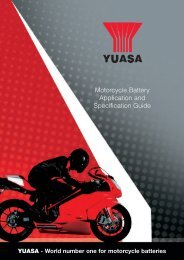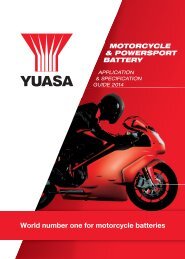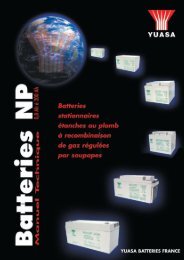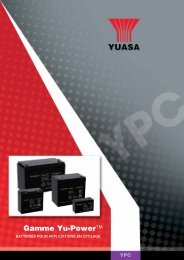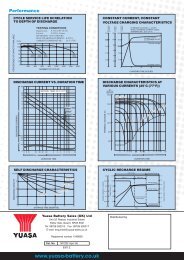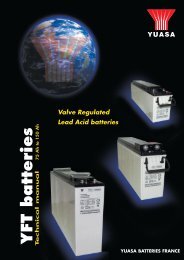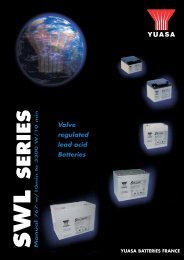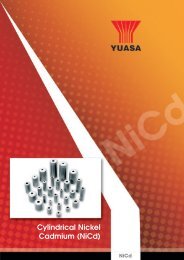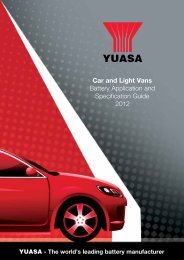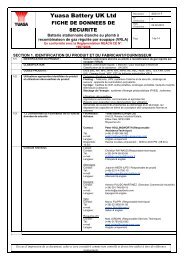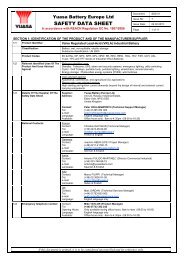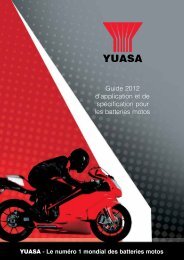YUASA - The world's leading battery manufacturer
YUASA - The world's leading battery manufacturer
YUASA - The world's leading battery manufacturer
You also want an ePaper? Increase the reach of your titles
YUMPU automatically turns print PDFs into web optimized ePapers that Google loves.
Information<br />
Material Safety Data continued<br />
Issue Level 3, Issue Date 19.02.2008<br />
or cover rings and bracelets with insulating material when<br />
working on or handling batteries.<br />
- Keep all sources of ignition away from batteries.<br />
- NEVER short circuit the terminals to establish whether or not<br />
a <strong>battery</strong> is charged.<br />
- Keep the electrolyte topped up to the correct level.<br />
- Recharge batteries at the rate recommended by the<br />
<strong>manufacturer</strong> in a well ventilated area.<br />
- Disconnect the <strong>battery</strong> before working on or near any<br />
exposed part of the vehicle electrical system.<br />
- Store batteries upright in single layers in a well ventilated<br />
area, never obstruct the cell vents.<br />
- Batteries are heavy; correct lifting techniques should be<br />
employed when lifting and handling.<br />
8. EXPOSURE CONTROLS/PERSONAL PROTECTION:<br />
When there is a risk from acid splashes wear chemical goggles<br />
or a full face visor and acid proof protective clothing including<br />
gloves and boots.<br />
Exposure to sulphuric acid mist generated during charging<br />
should be controlled by good natural ventilation or by local<br />
exhaust ventilation down to the current Occupational<br />
Exposure Standard given in HSE Guidance Note EH40.<br />
Contact with lead is restricted to the <strong>battery</strong> terminals unless<br />
the case is damaged. Always wash the hands with<br />
soap and warm water after handling batteries.<br />
9. PHYSICAL AND CHEMICAL PROPERTIES:<br />
<strong>The</strong> lead and lead compounds are in the form of solids which<br />
can only be exposed if the <strong>battery</strong> case is damaged. Sulphuric<br />
acid is a corrosive liquid which can escape through the cell<br />
vents if the <strong>battery</strong> is tipped over.<br />
10. STABILITY AND REACTIVITY:<br />
Sulphuric acid will react violently with other acids, alkalis and<br />
oxidising agents. In some cases toxic fumes may be evolved.<br />
Chlorine gas is given off when sea water enters a lead-acid<br />
<strong>battery</strong>, top up with pure fresh water only.<br />
11. TOXICOLOGICAL INFORMATION:<br />
SKIN CONTACT - Sulphuric acid causes severe burns and<br />
tissue destruction.<br />
EYE CONTACT - Sulphuric acid causes severe burns and<br />
tissue destruction.<br />
INGESTION - Sulphuric acid causes severe corrosion of the<br />
mouth, throat and digestive tract.<br />
- Lead and lead compounds are harmful if ingested.<br />
INHALATION - Sulphuric acid mist generated during charging<br />
can irritate the nose, throat and upper respiratory tract.<br />
- Lead can only be inhaled if released from the <strong>battery</strong><br />
container and then reduced to a dry airborne dust. Prompt<br />
disposal of waste will prevent exposure by this route.<br />
See DISPOSAL CONSIDERATIONS.<br />
12. ECOLOGICAL INFORMATION:<br />
Lead compounds and sulphuric acid will cause "harm" as<br />
defined in S29(5) of the Environmental Protection Act 1990.<br />
13. DISPOSAL CONSIDERATIONS:<br />
Damaged or spent batteries or residue from fires and spillages<br />
should be contained in closed acid proof receptacles, to<br />
prevent escape to the environment and disposed of as Special<br />
Waste.<br />
See REGULATORY INFORMATION.<br />
14. TRANSPORT INFORMATION:<br />
ROAD: UN Number<br />
UN2794<br />
Proper shipping name BATTERIES, WET, FILLED<br />
WITH ACID<br />
ADR labelling<br />
Class 8 hazard label,<br />
Corrosive substances<br />
Batteries packaged in accordance with SP598 of ADR 3.3 are<br />
exempt from ADR regulations and do not have to be labelled<br />
for conveyance. Batteries not complying with these special<br />
provisions are NOT exempt and so do have to bear the correct<br />
labelling. Batteries do not have to be individually marked if the<br />
pallet bears the appropriate mark (UN number) and hazard<br />
class label.<br />
SEA: UN Number UN2794<br />
IMDG Class<br />
8 Corrosive<br />
IMDG Page 8120<br />
Packing Group 3<br />
IMDG Label<br />
BATTERIES, WET, FILLED<br />
WITH ACID<br />
MFAG 700<br />
EmS 8-10<br />
AIR: UN Number UN2794<br />
Proper Ship Name<br />
BATTERIES, WET, FILLED<br />
WITH ACID<br />
IATA Class 8<br />
IATA Packaging Group 3<br />
IATA Label RCM CORROSIVE CLASS 8<br />
15. REGULATORY INFORMATION:<br />
CHIP: No label required for supply.<br />
For conveyance see TRANSPORT INFORMATION.<br />
COSHH: Sulphuric acid mist - for occupational Exposure Limit<br />
see HSE Guidance Note EH40.<br />
LEAD: <strong>The</strong> repair of most automotive batteries is<br />
impracticable due to the materials and the type of construction<br />
used. In cases where repairs are possible, (e.g. the<br />
replacement of a traction <strong>battery</strong> cell), only competent persons<br />
should be allowed to undertake the work and reference should<br />
be made to the Control of Lead at Work Regulations 2002.<br />
WASTE: All spent batteries and waste arising from spillages<br />
and fires must be disposed of in conformance with the<br />
Environmental Protection Act, the Special Waste Regulations<br />
1996 and the Environmental Protection (Duty of Care)<br />
Regulations 1991.<br />
198




